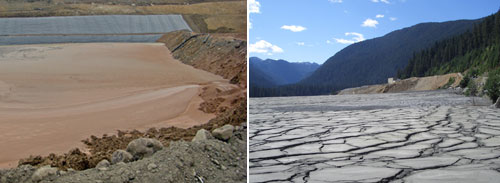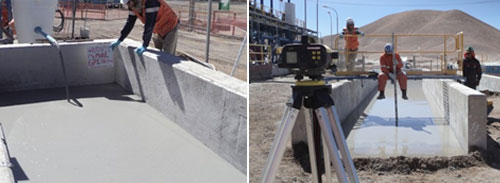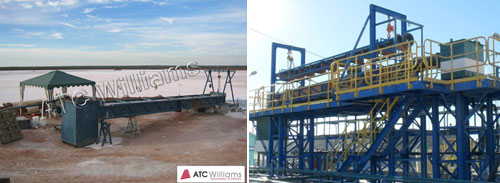Beach Slope Prediction
Beach Slope Prediction Methods

Figure 1: Beach slope for HDTT (left image shows fresh meander path; right image shows paste beach slope from right to left (© Jon Engels)
Introduction
Definition of beach slope
Beach slope in the tailings industry refers to the surface slope of the tailings after being hydraulically or mechanical deposited from a point of discharge. This is the slope the tailings settle at after being discharged from the end of a pipe. In sub-aerial deposition, the exposed surface of the tailings between the point of discharge and the supernatant pond (where present) or towards the low point within the storage area is referred to as the beach. In a few cases, tailings are deposited underwater (sub-aqueous) which generates a higher settled slope than sub-aerial deposition due, it is thought, to the higher density of the water compared to air (submerged beach conditions). It is the beach slope relating to sub-aerial deposition that is the main focus of attention in modern day tailings storage facility design and operational management.
The unit of beach slope is generally represented as percentage slope, but was traditionally represented in degrees (and occasionally still is).
Importance
The beach slope is an important parameter to consider in tailings storage facility design that can influence both initial construction (e.g. starter dyke requirements) and on-going operational costs (e.g. embankment raises, pond capacity). A flatter beach slope than designed for can create the following scenarios:
A higher beach slope than designed for can create the following scenarios:
The prediction of tailings beach slope is important to reduce operational risk and optimise the design of a storage facility. Today this is even more important as the trend in mine throughput and storage area footprints continue to increase due to advancements in mechanisation and processing technology. Prediction methods through simple and semi-industrial testing (i.e. pilot plants) can reduce long term operational costs associated with tailings storage through design and deposition management optimisation.
Beach Slope Prediction
Introduction
Methods of predicting the beach slope have advanced significantly in recent years, mainly due to the development of high density thickened tailings deposition where the resulting beach slope can vary greatly. Historically, with conventional low thickened tailings deposition, beach slopes could be expected to be in a typical range of 0.2 – 1.5% which can be managed, to some extent, if variations occur during the operational stage. However, today, where water conservation is becoming more prominent, the need to reduce losses through seepage, retention and evaporation within a tailings storage facility can be reduced through higher rates of thickening of tailings. This has additional advantages, as by increasing the beach slope, the perimeter retaining wall heights or the storage facility footprint can be reduced compared to a conventional facility design (i.e. for the same required storage volume). This can reduce CAPEX and OPEX expenditure as well as reduce water management requirements once in the operational phase.
Beach slopes for HDTT and paste can range between 2 – 10% which can have a significant impact on facility design and day to day tailings discharge management. For this reason, beach slope prediction methods have become a focus of attention over the recent years to try and improve this important design parameter that greatly influences the design and operation of a tailings storage facility.
An added complication in beach slope prediction is that it is not uncommon for the beach slope to vary with distance from a point of discharge producing either a concave or even convex beach shape. This variation is dependent on the tailings properties, deposition flow rate and the timeframe from when deposition commenced. In beach slope prediction methodology, the shape of the beach can also be derived.
Methodology
At the present time there are two methodologies that are considered to be at the current forefront of beach slope prediction. These are:
- McPhail Method
- A method of beach slope prediction using the stream power entropy approach developed during research for a PhD thesis submitted in 1995 by Dr Gordon McPhail.
- ATC Williams Method
- Developed originally by Paul Williams in the 1980´s and later studied and further developed through the research of two PhD students, Dr Tim Fitton and Dr Benham Pirouz.
There are other methods of beach slope prediction used, mostly on a laboratory scale. It is generally accepted in the tailings industry that depositing tailings in a narrow or fish tank style flume and measuring the beach slope directly will not yield reliable results that can be modelled to predict the full scale beach slope. Quite often, and has been seen in current operational facilities, that the beach slope is lower than what was predicted through assessments made in these styles of small scale trials. Some of the fundamental reasons behind this are as follows:
Laboratory flumes or small onsite flumes are sometimes used as visual reassurance to tailings facility designers and their clients. The fact is that quite often these styles of tests are fundamentally wrong in their design and approach to beach slope prediction, particularly if the mistake is made of scaling up the slope from the flume to the full scale operation.
The methods of McPhail and ATC Williams are distinctly different in their methodologies and approach to prediction. They are continually being improved, but have advanced greatly over recent years thanks to the demand from industry for operational based testing on semi-industrial scales. The two distinct methods don’t provide the precise answer, but provide a prediction to beach slope with a higher level of confidence when compared to other methodologies used today. Both consulting companies accept that there are further improvements that can be made to try and develop the art to beach slope prediction. Their methods are discussed separately in the following sections.
McPhail Method
Introduction
The method was developed during research for a PhD thesis submitted in 1995 by Gordon McPhail at the University of Witswatersrand in South Africa. The supervisor for the thesis was Professor Geoffrey Blight who is well renowned in the tailings industry and has supervised other research relating to beach slope prediction (most notable Bentel). The title of McPhail’s thesis, “Prediction of beaching characteristics of hydraulically placed tailings” was originally developed for conventional tailings and later adapted to HDTT.
McPhail’s method relates the beach profile to the energy of the flow of tailings as they move away from the plunge pool (i.e. from a point of discharge) and continue downstream in channel flow. The energy per unit time of this flow is defined as the “Stream Power”. The key measurements to determine this are made around the plunge pool, the exit conditions of the discharge pipe, and along the advancing tailings beach.
The technicalities of the method are not presented here, but the following references provide more insight into the theory and implementation of the method in industry:
The first paper referenced above is by Dr Paul Simms who has presented an excellent comparison of both McPhail’s and ATC Williams’ methods. Dr Simms has also developed and presented in this paper his own method derived through theoretical and laboratory research relating to the lubrication theory.
Onsite Testing
McPhail’s onsite flume tests can be constructed quickly and cheaply. A single solid concentration can be tested in less than a day in two independent sized flumes (where necessary), which includes deposition, specific beach formation/energy measurements, sample collection, laboratory rheology testing and site specific data required by Dr Gordon McPhail to develop the beach profile model.

Figure 2: McPhail flume testing (left, small flume; right, beach slope formation measurements) (© Jon Engels)
The volume of tailings required to run the trials is low (determined by pilot thickener output) with actual discharge times to form the beach in the order of 5 – 15 minutes per test. This allows for flexibility in tailings availability and daily operation when considering other testing campaigns normally associated with pilot plant operations (e.g. pipe loops, thickener optimisation time).
Flume design is made by Dr McPhail which is dependent on site specific and tailings related parameters.
ATC Williams Method
Introduction
The methods of ATC Williams were originally developed by Paul Williams in the 1980´s and later advanced by Dr Tim Fitton and Dr Benham Pirouz who submitted their PhD theses at RMIT University in Melbourne and K.N.Toosi University in Tehran, Iran respectively.
The methodology is focused towards an equilibrium approach, defined as the point between erosion and sedimentary deposition. This integrates non-Newtonian open channel flow and sediment transport. The equilibrium is characterised by the minimum transport velocity for the tailings which can be determined through experimental measurements or various equations.
The technicalities of the method are not presented here, but the following references provide more insight into the theory and implementation of the method in industry:
Onsite Testing
The experimental method of ATC Williams considers flow-through flume testing as a way to determine the beach slope for a given flow of tailings slurry. This flume testing can be achieved with or without a pilot plant thickener. ATC Williams have produced a number of designs for flow-through flumes, each to suit the infrastructure available at a given test site. ATC Williams's flow-through tilting flumes can operate under various slurry flow rates and concentrations. The basis for the use of a flow-through flume is that the slope of a channel that forms on a tailings beach dictates the slope of the tailings beach itself. The flume can be run in two ways; either with rigid half-pipes or with self-formed channels.

Figure 3: Flow through flumes of ATC Williams (left, non-closed loop; right, closed loop system) (© ATC Williams & Jon Engels)
Preferably the flow-through flumes are operated as a closed loop to ensure a constant uninterrupted flow feed. Tailings are charged to a holding tank and pumps used to feed a smaller tank at the head of the flumes, the overflow from the flumes thus charging the holding tank downstream. The pumps operate on a continuous basis to form a constant flow and the flume angle is adjusted to determine the equilibrium slope for the particular concentration of tailings under test. Profile measurements are made throughout the testing as well as sample collection for laboratory rheological tests.
Flume design is determined by ATC Williams which is dependent on site specific and tailings related parameters.
The Importance of Tailings Properties
It is important to consider that quite often the tailings properties for full scale operations are different to metallurgical trials. The particle size distribution of the tailings, rheological conditions, as well as the final deposition solids concentrations will influence the beach slope predictions made. For this reason it is important in any prediction methodology to consider samples of tailings that have the same or near similar properties as the proposed final tailings from the full scale plant. More common today is the use of semi-industrial pilot plants (or demo plants) commissioned at existing operations to utilise actual mine tailings with an onsite pilot thickener. This ensures the supply of a constant feed of tailings that can be thickened and deposited at a range of different solids concentrations to determine sensitivity of beach slope variations.
Some operational tailings facilities that have a flatter beach slope than predictions made through beach slope analyses are often a consequence of changes in the properties of the tailings discharged compared to design/testing tailings data. This is particularly true for mining operations that are not operational (feasibility stage) where samples were provided through small scale metallurgical trials. This can produce very different tailings properties, particularly if the full scale mineral processing methods have not been finalised during metallurgical trial development.
The author is aware of two HDTT facilities now in operation that were originally predicted to have a higher beach slope than actual operational values. In these two cases there is a distinct difference between the design data and operational properties of the tailings, this is likely to have caused this variation. Principally, the design solids concentration has not been achieved, resulting in a lower yield stress of the tailings. In one of these examples there is a finer grind size of the tailings. This variation will also influence the final beach slope.
Closing Comments
Beach slope prediction is an art, but common sense and experience in running these types of experimental tests can be very important. There are many operational influences that need to be assessed in any prediction techniques. The advantage that McPhail and ATC Williams have is through operation of their methodologies for a range of ores types and scales of onsite industrial experimental operation.
It is important that a range of solids concentrations are tested during beach slope prediction trials, and that a mining operation has a vendor guarantee that the thickeners will achieve the target solids concentration at full scale operation. Semi-industrial or demo plant testing has a distinct advantage to determine limitations of thickening which some high throughput mines have implemented to reduce operational risk. Beach slope and transportation related testing (e.g. pipe loops and pump testing) of the derived tailings product from these large scale plant trials can create increased confidence in the parameters used in the design of a tailings storage facility.
There are other up and coming techniques in beach slope prediction that have potential, like Simms’ and Alan Li`s approaches, but they require practice and assessment through industrial scales of operation. It is hoped that these methods can be incorporated by mineral operators in future testing programmes, and thus further assist the tailings industry to resolve a challenging technical design parameter with a higher level of confidence.
